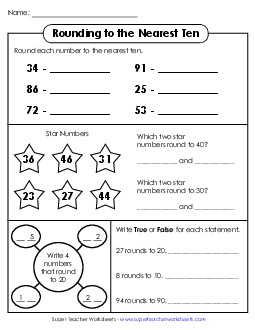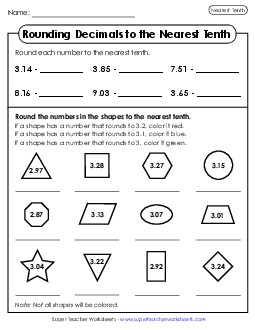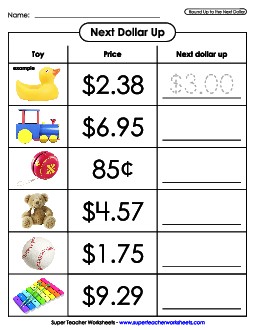Rounding

If you're teaching kids to round 2 and 3-digit numbers to the nearest ten, take a look at this page. It has a Scoot game, lots of worksheets, and rounding charts.
(examples: 75 rounds to 80; 167 rounds to 170)
On this worksheets, pupils will round numbers to the nearest hundred. There's also a section for rounding to nearest ten and hundred (mixed).
(examples: 345 rounds to 300; 1,677 rounds to 1,700)
This section has a few printables on rounding to the nearest thousand.
(example: 5,765 rounds to 6,000)
Round decimals to the nearest tenth, hundredth, thousandth, and/or whole number.
(example: 2.67 rounds to 3)
Round money amounts to the nearest dollar. There's a math riddle activity, and practice worksheets.
(example: $6.71 rounds to $7.00)
Round each amount up to the next dollar to determine how many bills to give a cashier.
(example: $4.12 rounds up to $5.00)
Super Teacher Worksheets has a HUGE collection of place value worksheets. Use these resources for teaching kids about comparing and ordering numbers, place value blocks, expanded notation, and digit values.



Rounding is an essential math skill taught in elementary school, usually introduced in the second or third grade and continuing through fourth and fifth grades as students encounter more complex numbers and decimals. Rounding helps students simplify numbers, making them easier to work with in estimation, mental math, and everyday life scenarios, such as estimating costs while shopping. The basic concept of rounding involves finding the nearest value, whether rounding to the nearest ten, hundred, or another place value. As students progress, they also learn to round decimals and amounts of money, which is crucial for financial literacy and other real-world applications.
In the classroom, students are taught to round numbers through a variety of engaging and hands-on methods. Teachers often begin by introducing number lines, where students visually see how numbers fall between place values and learn to round up or down depending on where the number lies. Interactive activities like rounding games, where students roll dice and round the results to the nearest ten or hundred, help reinforce the concept in a fun, memorable way. Word problems involving real-life scenarios, such as rounding money when making purchases or rounding distances when estimating travel, help students apply rounding in meaningful contexts. Digital tools and rounding worksheets also offer practice in rounding decimals, preparing students for more advanced math topics like fractions and percentages.
Understanding the core concepts of rounding is critical for students as it enhances their number sense and ability to work with large or complex numbers quickly and efficiently. Rounding helps students make reasonable estimates, which is especially useful in daily tasks like budgeting, cooking, or measuring. It also supports more advanced math operations, such as multiplying and dividing large numbers or working with decimals and fractions in higher grades. Super Teacher Worksheets' rounding printables help focus on every day challenges that children will encounter. Mastering rounding builds a strong foundation for mathematical reasoning and problem-solving, helping students succeed in both academics and practical life situations.






